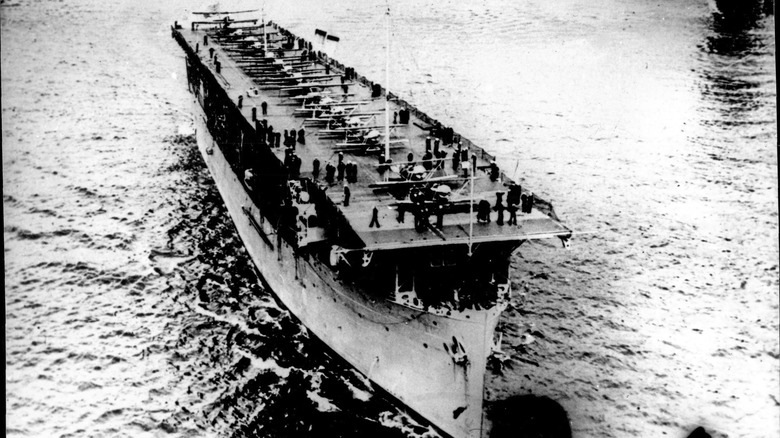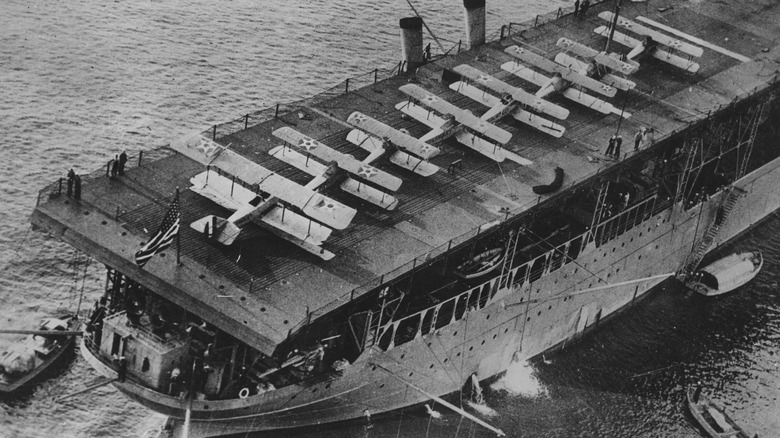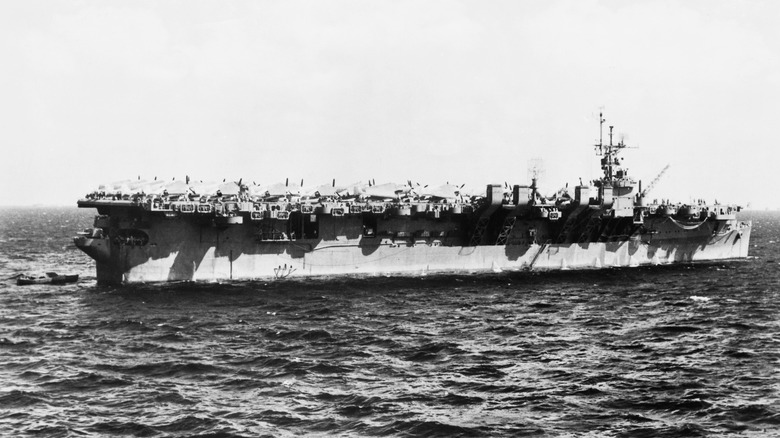The Story Of The U.S. Navy's First-Ever Aircraft Carrier
Aircraft carriers are the most important and impressive vessels in the U.S. Naval fleet, and it's been that way for decades. The first aircraft carrier, or more accurately, the first time a plane launched from a naval vessel, took place in 1912 from the French seaplane carrier Foudre. Other nations saw what was possible with naval aviation and soon joined in on the race to build effective and efficient mobile naval launch platforms.
While European nations started the aircraft carrier craze just prior to the outbreak of World War I, the United States wasn't too far behind. The construction of the USS Langley (CV-1/AV-3), the U.S.' first aircraft carrier, began in 1911. It took over a decade before the Langley could set sail as a carrier, which she did multiple times. She was ultimately commissioned, decommissioned, and recommissioned multiple times between 1913 and 1942.
When the Langley first launched in 1913, she was called the Jupiter and began life as a Proteus-class collier, which was a type of cargo ship used around the turn of the century. Eventually, the need for change arose alongside the advent of advanced technology, enabling shipbuilders to alter her configuration and install a deck. Once this was done, the Langley became the U.S. Navy's first aircraft carrier, and she served with distinction for decades.
The USS Langley (CV-1/AV-3)
The USS Jupiter entered service in 1913 as a collier, and she was the first U.S. ship powered by turbo-electric power. The Jupiter's lack of a steam turbine ensured she was faster than her sister ships — the USS Cyclops and Neptune. The Jupiter initially served in the Pacific, and when it crossed the Panama Canal, it was the first vessel to do so from east to west. She didn't see any action during World War I, and on July 11, 1919, the Navy authorized her conversion into an aircraft carrier.
The Jupiter was then decommissioned the following March and her conversion began. On April 21, 1920, she was reclassified CV-1 and renamed the Langley, becoming the first U.S. aircraft carrier. While she was initially built for that purpose, from 1920-on, the Langley was no longer a collier. Much of the Langley's early service record involved testing naval aviation, including launching planes and recovering them while underway.
When she was recommissioned, the Langley's design accommodated a surprisingly high number of aircraft. Some modern carriers can support as many as 90 fighter jets, but initially, the number was much lower. That said, the Langley's ability to carry up to 34 airplanes was a monumental achievement in 1922. The Langley could support 12 single-seat "Chasing" aircraft, another dozen two-seat "spotters," and ten planes outfitted to drop torpedoes at speeds up to 80 knots (92 mph) into the water.
The Langley's service history
The USS Langley had a distinguished service record, and throughout most of it, she functioned as a training vessel. From 1927 until 1939, the Langley operated in the Pacific off the coasts of Hawaii and California. During this time, the she trained units on naval aviation; she also housed numerous experiments for advancing that technology, pilot training, and more. She was even featured in a silent movie about naval aviation called "The Flying Fleet."
In 1936, the Langley underwent an overhaul and conversion, abandoning the CV-1 classification for AV-3 on April 21, 1947. The Langley then served for a time in the Atlantic before making her way back to the Pacific just in time for the outbreak of World War II. During the conflict, the Langley functioned as an antisubmarine ship in the Pacific, and continued after the United States entered WWII following the Japanese sneak attack on Pearl Harbor in December 1941.
On February 27, 1942, the Langley joined two destroyers, the USS Whipple (DD-217) and Edsall (DD-219), for antisubmarine efforts. Just before noon, nine Japanese bombers set the Langley in their sights, and attacked. The first effort failed, but the Japanese landed five hits, causing the Langley's deck and her aircraft to burst into flames. The Langley didn't sink, but she was dead in the water. Her destroyer escorts fired nine four-inch shells and a couple of torpedoes at the Langley, scuttling her 75 miles south of Tjilatjap, Indonesia.


